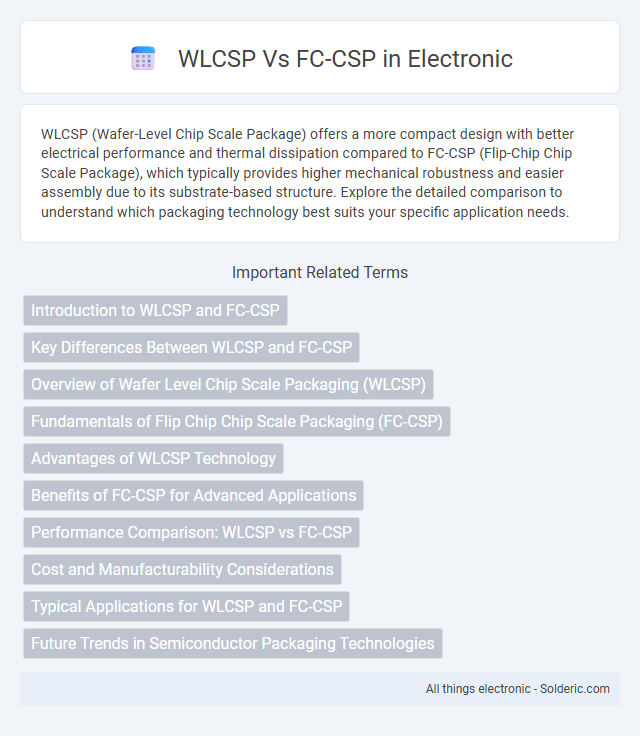WLCSP (Wafer-Level Chip Scale Package) offers a more compact design with better electrical performance and thermal dissipation compared to FC-CSP (Flip-Chip Chip Scale Package), which typically provides higher mechanical robustness and easier assembly due to its substrate-based structure. Explore the detailed comparison to understand which packaging technology best suits your specific application needs.
Comparison Table
| Feature | WLCSP (Wafer-Level Chip-Scale Package) | FC-CSP (Flip-Chip Chip-Scale Package) |
|---|---|---|
| Packaging Process | Packaged at wafer-level before dicing | Chip flipped and soldered onto substrate |
| Size | Very compact, true chip-scale size | Slightly larger due to substrate |
| Thermal Performance | Limited heat dissipation | Better thermal management via substrate |
| Electrical Performance | Short interconnects, low parasitics | Low inductance, suitable for high speed |
| Manufacturing Cost | Lower cost, fewer process steps | Higher cost, additional substrate |
| Reliability | Good moisture resistance | Higher mechanical stress tolerance |
| Common Applications | Mobile devices, compact electronics | High-performance computing, automotive |
Introduction to WLCSP and FC-CSP
Wafer-Level Chip-Scale Packaging (WLCSP) integrates the packaging process directly on the wafer, allowing for reduced package size and improved electrical performance by minimizing the interconnect length. Flip-Chip Chip-Scale Packaging (FC-CSP) utilizes a flip-chip technique where the die is mounted face-down onto the substrate with solder bumps, enhancing thermal dissipation and enabling higher input/output density. Both WLCSP and FC-CSP offer compact form factors suited for high-performance applications, with WLCSP emphasizing wafer-level processing and FC-CSP focusing on flip-chip interconnection.
Key Differences Between WLCSP and FC-CSP
WLCSP (Wafer-Level Chip-Scale Package) and FC-CSP (Flip-Chip Chip-Scale Package) differ primarily in their manufacturing processes and structural designs. WLCSP is fabricated directly on the wafer, providing a smaller footprint and improved electrical performance due to shorter interconnections, while FC-CSP involves flip-chip bonding onto a substrate, which offers better heat dissipation and mechanical stability. Your choice between WLCSP and FC-CSP depends on factors like application requirements, thermal management needs, and package size constraints.
Overview of Wafer Level Chip Scale Packaging (WLCSP)
Wafer Level Chip Scale Packaging (WLCSP) is an advanced semiconductor packaging technology where the entire packaging process occurs at the wafer level, offering a compact and cost-effective solution with minimal package size and excellent electrical performance. WLCSP is designed to enhance heat dissipation and signal integrity by reducing parasitic inductance and capacitance, making it ideal for high-frequency applications. Your choice between WLCSP and FC-CSP should consider factors like assembly complexity, mechanical strength, and thermal management requirements.
Fundamentals of Flip Chip Chip Scale Packaging (FC-CSP)
Flip Chip Chip Scale Packaging (FC-CSP) uses solder bumps for direct electrical connections between the die and substrate, enabling superior electrical performance and thermal dissipation compared to traditional wire bonding. The FC-CSP process integrates the semiconductor die without an interposer, achieving a smaller footprint closely matching the chip size, which enhances miniaturization in electronic devices. This packaging method ensures robust mechanical stability by evenly distributing stresses across the solder bumps, crucial for high-reliability applications in mobile and wearable technologies.
Advantages of WLCSP Technology
WLCSP technology offers significant advantages such as a smaller package size and thinner profile compared to FC-CSP, enabling better space utilization in compact electronic devices. Enhanced electrical performance results from shorter interconnects, reducing signal distortion and improving overall device reliability. Your designs benefit from simplified assembly processes and improved thermal dissipation, leading to cost-effective manufacturing and higher product durability.
Benefits of FC-CSP for Advanced Applications
FC-CSP offers superior thermal performance and mechanical reliability compared to WLCSP, making it ideal for advanced applications with high power densities. Its flip-chip interconnection increases signal integrity and supports higher I/O counts, which is critical for complex semiconductor designs. Enhanced package robustness and smaller form factors enable FC-CSP to meet stringent requirements in mobile, automotive, and IoT devices.
Performance Comparison: WLCSP vs FC-CSP
Wafer-Level Chip-Scale Packages (WLCSP) typically offer lower parasitic inductance and capacitance compared to Flip-Chip Chip-Scale Packages (FC-CSP), enabling better high-frequency performance and improved signal integrity. FC-CSP provides superior thermal dissipation and mechanical robustness, which enhances reliability in high-power applications. Performance trade-offs between WLCSP and FC-CSP depend on specific use cases, with WLCSP favoring miniaturization and electrical efficiency, while FC-CSP excels in thermal management and mechanical stability.
Cost and Manufacturability Considerations
WLCSP (Wafer-Level Chip-Scale Package) offers lower manufacturing costs due to reduced material usage and simplified assembly processes compared to FC-CSP (Flip-Chip Chip-Scale Package), which requires more complex underfill and substrate handling. WLCSP enables high-volume production with fewer process steps, enhancing throughput and yield, while FC-CSP involves intricate flip-chip bonding and solder bump formation, increasing fabrication complexity and cost. The choice between WLCSP and FC-CSP depends on application-specific requirements balancing cost-efficiency and manufacturing capabilities.
Typical Applications for WLCSP and FC-CSP
WLCSP (Wafer-Level Chip Scale Package) is commonly used in smartphones, wearable devices, and high-density electronics where compact size and excellent electrical performance are crucial. FC-CSP (Flip Chip Chip Scale Package) finds typical applications in high-performance computing, automotive electronics, and advanced consumer electronics requiring superior thermal management and high I/O counts. Your choice between WLCSP and FC-CSP depends on specific application demands such as size constraints, electrical performance, and thermal requirements.
Future Trends in Semiconductor Packaging Technologies
WLCSP (Wafer-Level Chip-Scale Packaging) and FC-CSP (Flip-Chip Chip-Scale Packaging) are evolving to meet the demands of miniaturization, higher performance, and improved reliability in semiconductor packaging. Emerging trends emphasize enhanced thermal management, finer pitch interconnects, and integration with advanced substrates like silicon interposers and fan-out wafer-level packaging (FOWLP). Your product designs will benefit from these innovations by achieving better electrical performance and more efficient space utilization in next-generation electronic devices.
WLCSP vs FC-CSP Infographic

 solderic.com
solderic.com